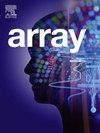Meta-learning based softmax average of convolutional neural networks using multi-layer perceptron for brain tumour classification
IF 2.3
Q2 COMPUTER SCIENCE, THEORY & METHODS
引用次数: 0
Abstract
Brain tumour classification using Magnetic Resonance Imaging (MRI) is crucial for medical decision-making. The variability in tumour shape, size, and position poses challenges to classification methods. Convolutional Neural Networks (CNNs) are commonly used due to their proven performance, but their effectiveness diminishes with the high variability of tumour characteristics. This study proposes a meta-learning approach, leveraging the softmax average of multiple CNN models with a Multi-Layer Perceptron (MLP) as the meta-learner. The base-learner models include MobileNetV2, InceptionV3, Xception, DenseNet201, and ResNet50. This approach combines the softmax outputs of these CNN models, capturing their strengths to handle diverse tumour characteristics. The averaged outputs are fed into the MLP for increased classification performance. To evaluate the proposed method, we used several brain MRI image datasets, including Dataset 1 (Thomas Dubail Dataset), Dataset 2 (Mesoud Nickparcar Dataset), and Dataset 3 (Fernando Feltrin Dataset). The test results showed the proposed method's effectiveness in improving classification performance. For Dataset 1, the MLP with one hidden layer (128 neurons) achieved 97.47 % accuracy, improving the base learners' performance by 1.94 %–7.42 %. On Dataset 2, the MLP with 64 neurons reached 99.54 % accuracy, with a 0 %–2.44 % improvement. For Dataset 3, an MLP with two hidden layers (256 and 125 neurons) achieved 98.87 % accuracy, enhancing performance by 0.46 %–5.67 %.
基于元学习的卷积神经网络软最大值平均(使用多层感知器)用于脑肿瘤分类
使用磁共振成像(MRI)进行脑肿瘤分类对医疗决策至关重要。肿瘤形状、大小和位置的可变性对分类方法提出了挑战。卷积神经网络(cnn)由于其成熟的性能而被广泛使用,但其有效性随着肿瘤特征的高度可变性而降低。本研究提出了一种元学习方法,利用多层感知器(MLP)作为元学习器,利用多个CNN模型的softmax平均值。基础学习器模型包括MobileNetV2、InceptionV3、Xception、DenseNet201和ResNet50。这种方法结合了这些CNN模型的softmax输出,捕捉了它们处理不同肿瘤特征的优势。平均输出被输入到MLP中以提高分类性能。为了评估提出的方法,我们使用了几个脑MRI图像数据集,包括数据集1 (Thomas Dubail数据集),数据集2 (Mesoud Nickparcar数据集)和数据集3 (Fernando Feltrin数据集)。实验结果表明,该方法在提高分类性能方面是有效的。对于数据集1,具有一个隐藏层(128个神经元)的MLP达到了97.47%的准确率,将基础学习器的性能提高了1.94% - 7.42%。在数据集2上,64个神经元的MLP准确率达到99.54%,提高了0% - 2.44%。对于数据集3,具有两个隐藏层(256和125神经元)的MLP准确率达到98.87%,性能提高0.46% - 5.67%。
本文章由计算机程序翻译,如有差异,请以英文原文为准。
求助全文
约1分钟内获得全文
求助全文

 求助内容:
求助内容: 应助结果提醒方式:
应助结果提醒方式:


